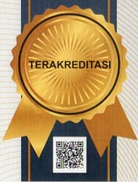Tangible and Natural Of Indonesian Cultural Heritage Presented In English Textbooks For Senior High School Student
Abstract
Cultural elements play an essential role in learning a foreign language; thus, it is unavoidable that EFL (English Foreign Language) textbooks carry cultural elements. This study was framed with qualitative research and aim to explore the presence of intangible and tangible cultural heritage in the visual materials (painting, photography, drawing, digital drawing) and to examine their distribution according to their types. The data to be analyzed was obtained from two textbooks for senior high school students entitled English Skills for Better Future for grade tenth and eleventh in senior high school. Content analysis was applied to analyze types of visual materials that present cultural heritage. The result showed that 163 visuals material were determined as 84 photos, 14 digital drawings, nine brochures, 35 advertisements, four flyers, nine forms, 16 proverbs, and one riddle. Cultural bias and stereotypes have not been detected in the images presented in both textbooks with the same title for 10th and 11th grade students in senior high school. The images presented are suitable for students at the senior high school level. Visual has an aesthetic value and aims to bring students to know the various Indonesian culture elements presented in these textbooks. Teachers and students who use books published by PT Grafindo Medika Pratama as a learning resource, this study might help in mapping the type of culture presented in the textbooks.
Keywords: Indonesian, cultural, heritage, visual, textbook
Abstrak
Unsur budaya memainkan peran penting dalam mempelajari bahasa asing; Dengan demikian, tidak dapat dipungkiri bahwa buku teks EFL (Bahasa Asing Inggris) mengandung unsur budaya. Dibingkai dengan penelitian kualitatif, penelitian ini bertujuan mengeksplorasi keberadaan warisan budaya berwujud benda dan tak benda yang disajikan dalam bentuk gambar (lukisan, fotografi, gambar, gambar digital) dan mengkaji sebarannya menurut jenisnya. Data yang akan dianalisis diperoleh dari dua buku siswa yang berjudul English Skills for the Future. Kedua buku ini digunakan oleh siswa kelas sepuluh dan sebelas di sekolah menengah atas. Analisis isi digunakan untuk menganalisis jenis gambar yang menjelaskan warisan budaya. Hasil penelitian menunjukkan bahwa 163 gambar yang ditampillan, 84 berupa foto, 14 gambar digital, sembilan brosur, 35 iklan, empat brosur, sembilan formulir, 16 peribahasa, dan satu teka-teki. Bias budaya dan stereotip belum terdeteksi dalam gambar yang disajikan di kedua buku teks dengan judul yang sama untuk siswa kelas 10 dan 11 SMA. Gambar yang disajikan sesuai untuk siswa di tingkat sekolah menengah atas. Visual yang disajikan memiliki nilai estetika dan bertujuan agar siswa mengenal berbagai unsur budaya Indonesia yang disajikan dalam buku teks tersebut. Guru dan siswa yang menggunakan buku terbitan PT Grafindo Medika Pratama sebagai sumber belajar, penelitian ini dapat membantu dalam memetakan dan mendeskripsikan jenis budaya yang disajikan dalam buku teks.
Kata Kunci: Indonesia, budaya, warisan, gambar, bukuteks,
Keywords
Full Text:
PDFReferences
Adnyani, N. L. P. S. (2011). Introducting Target Language Culture Through Movie Watching and Discussion. Jurnal Pendidikan Dan Pengajaran, 1–3, 77–83.
Byram, M., Gribkova, B., Starkey, H., & Sheils, J. (1997). Developing the Intercultural Dimension in Language Teaching a Practical Introduction for Teachers. A Practical Introduction for Teachers, 35.
Cesur. (2019). Evaluation of EFL Textbook ‘ Traveller Elementary ’ from the Perspective of Instructors and University Students. International Journal of Language and Literary Studies, 1(2), 1–16. https://doi.org/10.36892/ijlls.v1i2.46
Cortazzi, M., & Jin, L. (1991). Culture in Second Language Teaching and Learning. Cambridge University Press.
Elyas, T. (2014). English in the Kingdom of Arab Saudi. JWorld English, 33, 128–142. https://doi.org/DOI: 10.1111/weng.12073
Hadisaputra, I. N. P., & Adnyani, N. L. P. S. (2012). The Influence of Balinese Culture on EFL University Students Speaking Ability. Lingua Scientia, 19(2), 13–26.
Ismail, C. (2012). Developing cultural awareness in foreign language teaching. Turkish Online Journal of Distance Education, 5(3), 95–99. https://doi.org/10.5539/elt.v5n3p95
Kaplan, B. G. and K. (2019). Intangible Cultural Heritage Elements in the Visual of the 6th Grade Turkish Textbook. Journal of Language and Linguistics Studies, 15(1), 291–306. https://doi.org/10.17263/jlls.547742
Kasim, Wardoyo, H. (2017). Batik Classification with Artificial Neural Network Based on Texture-Shape Feature of Main Ornament. International Journal of Intelligent Systems and Applications, January 2018. https://doi.org/10.5815/ijisa.2017.06.06
Lewicka, M., & Waszau, A. (2017). Analysis of Textbooks for Teaching Arabic as a Foreign Language in terms of the Cultural Curriculum. Universal Journal of Educational Research, 5(1), 36–44. https://doi.org/10.13189/ujer.2017.050105
Memis. (2016). Educational Environment and Cultural Transmission in Foreign Language Teaching. International Periodical for the Languages, Literature and History of Turkish or Turkish, 11, 605–616. https://doi.org/http://dx.doi.org/10.7827/TurkishStudies.9506
Munandar, A. A. (2016). BOROBUDUR TEMPLE : THE INTERCHANGE OF HUMANITY VALUES AND ANCIENT ARCHITECTURE DEVELOPMENT IN International Review of Humanities Studies. International Review of Humanities Studies, 1(2).
Timbul Raharjo, Toyibah Kusumawati, S. T. W. (2013). Creative Batik Motif Design Based on Local Cultural Art and Natural Environments. China-USA Business Review, 13.
Ulum, Ö. G. (2016). Cultural issues in Syrian EFL classrooms. Journal of Human Sciences. https://doi.org/10.14687/jhs.v13i3.4009
UNESCO. (2003). Tangible and intangible Cultural Heritage | Riches Resources. http://resources.riches-project.eu/glossary/tangible-and-intangible-cultural-heritage/
UNESCO. (2005). Convention for the Safeguarding of the Intangible Cultural Heritage 2003. International Journal of Cultural Property, 12(4), 447–458. https://doi.org/10.1017/s0940739105050277
Xiong, T. (2017). The Representation of Gender in a Popular Primary School EFL Textbooks Series in China. International Journal of Education and Practice, 5(5), 79–87. https://doi.org/10.18488/journal.61.2017.55.79.87
Yeşil, Ş. (2017). An Exploration of English Language Teachers’ Perceptions of Culture Teaching and Its Effects on Students’ Motivation. International Journal of Progressive Education, 13(1), 79–95.
DOI: https://doi.org/10.32487/jshp.v5i1.889
Refbacks
- There are currently no refbacks.
JSHP: Jurnal Sosial Humaniora dan Pendidikan
is licensed under a Creative Commons Attribution-ShareAlike 4.0 International License (CC BY-SA 4.0)



